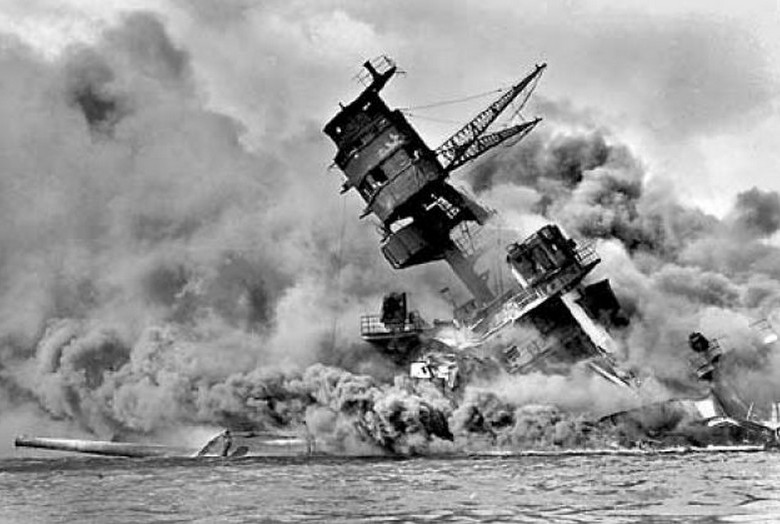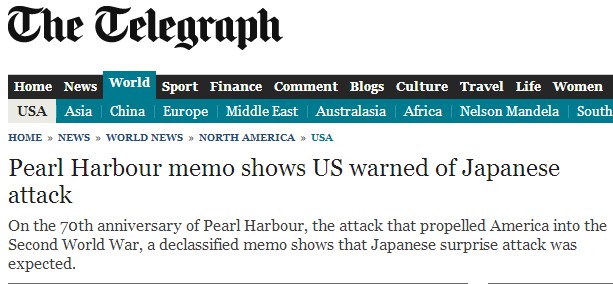Or perhaps not …..
Pearl Harbour memo shows US warned of Japanese attack – Telegraph
Said ex-President Herbert Hoover, Republican statesman of the day, “We have only one job to do now, and that is to defeat Japan.”
But to friends, “the Chief” sent another message: “You and I know that this continuous putting pins in rattlesnakes finally got this country bit.”
Today, 70 years after Pearl Harbor, a remarkable secret history, written from 1943 to 1963, has come to light. It is Hoover’s explanation of what happened before, during and after the world war that may prove yet the death knell of the West.
Edited by historian George Nash, Freedom Betrayed: Herbert Hoover’s History of the Second World War and Its Aftermath is a searing indictment of FDR and the men around him as politicians who lied prodigiously about their desire to keep America out of war, even as they took one deliberate step after another to take us into war.
Did FDR Provoke Pearl Harbor? by Patrick J. Buchanan — Antiwar.com




Why we now have DHS, TSA, snooping etc.
Transcript of 1997 Osama Bin Ladin interview by Peter Arnett
http://anusha.com/osamaint.htm
German say Assad did not order chem attack.
http://www.theguardian.com/world/2013/sep/08/syria-chemical-weapons-not-assad-bild
OK, Steve, you’ve crossed over to the twilight zone.
You’ve made some mistakes in the past, but I’ve passed commenting them so as not to “feed the trolls,” who are worse off than you, at least for now.
Anyone who thinks, as does Buchanan, that neither Hitler’s Germany nor Tojo’s Japan were a threat to America, is delusional.
As you become more “truther” than fact based, I find I can’t use your material for reference any more, even the good stuff, of which there’s plenty.
I do hope you come to your senses.
Best Regards from a former reader of your blog.
Don’t let the door hit your ass on the way out.
If Roosevelt allowed Pearl Harbor to happen, then he is the second biggest traitor in US history.
Just makes you wonder why the Aleutian recon flights were cancelled and the radar station personnel were sent on leave that day…..
Gotta keep the arms merchants and bankers rolling in dough, no matter how many lives are lost.
No but the US made ‘friends’ with Stalin’s Russia.
http://4.bp.blogspot.com/_Y_CvIxe4gBg/SxQBNYUApnI/AAAAAAAANc0/_AOJ_8RyLlA/s1600/churchill_roosevelt_stalin.jpg
Who needs enemies if you have friends like that. To think that Stalin ever would be a threat to America, is delusional.
Don’t forget that history is written by those who win the war, those in power. Just look how they rewrite the climate history.
Indefinite detention without charge or trial .
https://www.aclu.org/national-security/president-obama-signs-indefinite-detention-bill-law
I can’t see the difference with Hitler’s Germany or Stalin’s Russia or Mao’s China
Yes there is one BIG difference millions of Law abiding American citizens still have a weapon of mass destruction at home.
http://www.youtube.com/watch?v=V5kda1KhqlU
Why were there no carriers in Pearl Harbour that day?
The aircraft carrier had proved its worth long before December 1941, if the Japanese knew it then why not the the USN.
Taranto on the night of 11-12 November 1940
Battle of Cape Matapan on 27–29 March 1941
That’s why the Germans and Italians were so keen to sink British carriers and why Roosevelt kept his safe.
The 3 carriers were out on missions. One was delivering planes to Wake Island. The Japanese knew the value of carriers but our navy was still chock full of battleship admirals. Submarines were for long range scouting, carriers for short range, When the enemy was sighted everyone got out of the way of the battleships that would take care of business. Thanks to Japans huge blunder attacking us, they did us a favor by sinking the battleships and forcing us into using the subs and carriers as the main offensive weapons. Except for a few sea battles at Guadalcanal and later the Philippines the battleship was relegated to shore bombardment and guarding the carriers with their AA guns. Shortly before the war started the Brits sent two battleships to the Pacific to scare the Japanese who promptly sent them to the bottom using planes when hostilities commenced. British carriers and their swordfish planes were a joke and I know of no effort to hunt them down.
US carriers conveniently doing stuff?
The Stringbag was obsolete when it entered into service, however without aircover any ship is vulnerable..
HMS Victorious,
Her service in 1941 and 1942 included famous actions against the battleship Bismarck, several Arctic convoys and the Pedestal convoy to Malta. She was loaned to the United States Navy for a brief period in 1943 and served in the south west Pacific as USS Robin. Victorious contributed to several attacks on the Tirpitz. The elimination of the German naval threat allowed her redeployment first to the Eastern Fleet at Colombo and then to the Pacific for the final actions of the war against Japan.
Vulnerable carriers are more of a problem.
In March 1945, while supporting the invasion of Okinawa, the BPF had sole responsibility for operations in the Sakishima Islands. Its role was to suppress Japanese air activity, using gunfire and air attack, at potential Kamikaze staging airfields that would otherwise be a threat to US Navy vessels operating at Okinawa. The carriers were subject to heavy and repeated kamikaze attacks, but because of their armoured flight decks, the British aircraft carriers proved highly resistant, and returned to action relatively quickly. The USN liaison officer on the Indefatigable commented: “When a kamikaze hits a US carrier it means 6 months of repair at Pearl [Harbor]. When a kamikaze hits a Limey carrier it’s just a case of ‘Sweepers, man your brooms.’” -Wikipedia
Contrast HMS Formidable,HMS Indefatigable,HMS Indomitable, HMS Illustrious and HMS Victorious (also that Illustrious survived six hits by Ju 87 and Formidable two 1000lb bombs by Ju57 earlier in the war) with USS Franklin,USS Bunker Hill and USS Ticonderoga
All the best ships were taken out to sea, they left the rubbish in the harbour on purpose as they knew it was coming
It was well-known by the city of New York that the WTC was an asbestos bombshell. For years, the Port Authority treated the building like an aging dinosaur, attempting on several occasions to get permits to demolish the building for liability reasons, but being turned down due the known asbestos problem. Further, it was well-known the only reason the building was still standing until 9/11 was because it was too costly to disassemble the twin towers floor by floor since the Port Authority was prohibited legally from demolishing the buildings. [Arctic Beacon]
http://whatreallyhappened.com/WRHARTICLES/silverstein.html
How To Make a Huge Profit .
There was an interesting programme on a few years ago.
They presented clear evidence that Churchill and the British Intelligence Service knew about Pearl Harbour well beforehand. Churchill sensibly realised that this would get the US into the war with Germany so naturally kept quiet.
But there were indications that Roosevelt knew just as much.
In 1991 highly regarded historian John Toland wrote a book called INFAMY: PEARL HARBOR AND IT’S AFTERMATH. In it he detailed many many examples how Roosevelt should have known the Japanese were going to attack us. So this recent revelation isn’t anything new. Read the book, it’s a very good read. Many in the services did feel that an attack was imminent but they thought it would be the Philippines not Pearl Harbor. What’s really stupid is the Japanese did attack the Philippines a day or two later and they caught us flatfooted and creamed us.
I’m not a pacifist nor an isolationist, but I believe, as did Hoover, that when two equally evil sides are in conflict, let them kill each other and then defeat the victor if necessary.